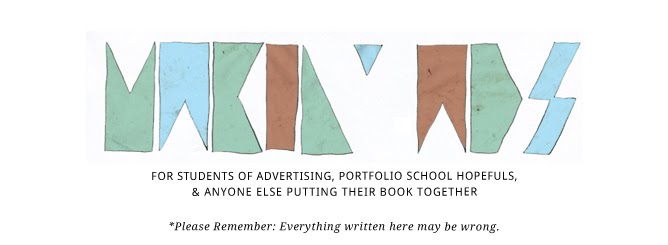! ! ! DOWNER ALERT ! ! !
This message contains downers. But it's not a downer message...
My agency's holding company recently announced a
worldwide hiring freeze. I believe it's in effect at least until February.
As part of that freeze, all job offers that were extended, but not accepted had to be rescinded. (i.e., if, say, Y&R, Ogilvy, or JWT offered you a job a couple weeks ago, it wasn't in your best interest to ask for a day to think about it).
A former student of mine recently told me he'd received two offers from very good shops which had been rescinded because of cutbacks. (Neither shop was a part of my agency's holding company. One is an international juggernaut. The other is a small boutique. Kind of shows you the scope things.)
DO NOT WORRY!
JUST KEEP WORKING!I left portfolio school just before the Dot Com crash. It was harder for the students the year behind me to get a job than it was for me. But they still got jobs. Some of them at hotter, higher-profile agencies.
If you really love advertising, it will show. If you have a thirst for creativity, it will shine through. If you know your destiny is to have amazingly cool ideas and put them on paper, TV, the web, and into the stratosphere, you'll stand out.
If anything, tough times weed out the people who weren't really interested in working in advertising anyway.
You can't control the economy.
You can't control the upcoming election.
You can't even get the CD's receptionist to return any of your emails.
But you can control how hard you work, and how much fun you have.
Stay focused on those two things, and you'll end up where you're supposed to be.


























 Whether you're grieving or celebrating McCain's loss today, there's something to learn from this:
Whether you're grieving or celebrating McCain's loss today, there's something to learn from this:

















